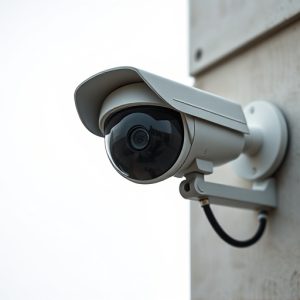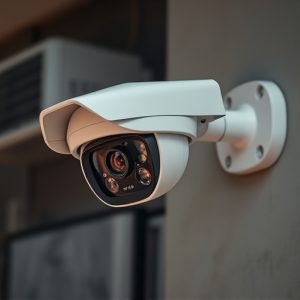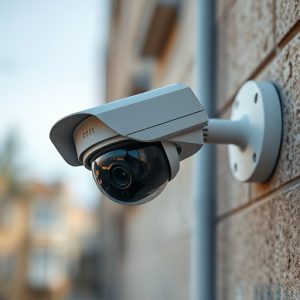Unveiling Deception: Navigating Risks of Fake Security Camera Height Placement
In today's digital era, fake security cameras disguised as monitoring devices have become a gro…….
In today's digital era, fake security cameras disguised as monitoring devices have become a growing concern. Criminals place these deceptive setups in strategic heights like doors, windowsills, or trees to record unsuspecting individuals without their knowledge. Homeowners and businesses must stay vigilant by inspecting security systems for unusual equipment or camera placements. Strategic camera placement is key: lower-mounted cameras offer detail but can be obstructed, while higher cameras provide broader views and better detect activity. Fake security cameras should be mounted at or slightly above eye level to deter intruders, positioned in visible areas like near windows or public spaces. However, there are significant risks and ethical considerations, as improper placement can obstruct genuine cameras and infringe on privacy rights, leading to legal and trust issues. Balancing security with privacy is crucial for effective and ethical surveillance practices.
In today’s digital age, security monitoring has evolved, but so have the tactics of those looking to deceive. This article delves into the phenomenon of fake security monitoring devices, exploring their design, placement strategies, and potential risks. From understanding the technology behind these fakes to examining the legal and ethical implications of their use, we uncover insights on how to identify and mitigate their impact. Key topics include the significance of camera height placement in deception and common tactics employed by fraudsters.
- Understanding Fake Security Monitoring Devices
- The Role of Camera Height in Deception
- Common Placement Techniques for Maximum Effect
- Identifying Risks and Potential Consequences
- Legal Implications and Ethical Considerations
Understanding Fake Security Monitoring Devices
Fake security monitoring devices, often disguised as genuine cameras, have become a growing concern in today’s digital age. These deceptive setups are meticulously designed to trick unsuspecting homeowners and businesses into believing they have robust security systems in place. One of the key indicators of a fake security camera is its unusual placement, such as extremely high or low positions that would be difficult for an intruder to access or view clearly.
Understanding the strategic height placement of these fake cameras is essential. Criminals often mount them in inconspicuous locations, like the tops of doors, windowsills, or even on trees nearby, aiming to record unsuspecting individuals without their knowledge. Homeowners and business owners must be vigilant and regularly inspect their security systems, checking for any unusual equipment or camera placements that might hint at a potential fake monitoring device.
The Role of Camera Height in Deception
The placement of security cameras is a strategic art, and one key aspect often overlooked is camera height. In the realm of deception, where the goal is to deter potential intruders, the camera’s vantage point can significantly impact its effectiveness. Lower-mounted cameras might capture detailed footage, but they also risk being obstructed by obstacles or individuals of certain heights, rendering them less useful for identification purposes. Conversely, higher camera positions offer a broader view and reduce the chances of blocking, making them ideal for detecting unusual activities in real time.
For a fake security monitoring device setup, mimicking actual camera height placement is essential to creating a convincing illusion. Strategically positioning cameras at various heights within a premises can deter thieves or vandals, as it suggests a comprehensive surveillance system. However, it’s crucial not to overdo it; a few well-placed cameras at different levels will have a more profound effect than numerous low-hanging cameras that might raise suspicions of being fakes.
Common Placement Techniques for Maximum Effect
When setting up fake security monitoring devices, strategic placement is key to achieving maximum deterrent effect. One of the most critical considerations is fake security camera height placement. Mounting cameras at eye level or slightly elevated positions mimics real surveillance systems, making potential intruders more cautious. This common technique allows for clear, unobstructed views of entry points, doors, and windows.
Additionally, placing these fake security devices in visible areas, such as near prominent windows or within the line of sight from streets or public spaces, serves as a powerful visual reminder of your property’s surveillance. The combination of realistic height placement and strategic positioning enhances the overall security perception, potentially discouraging criminal activity.
Identifying Risks and Potential Consequences
Setting up a fake security monitoring device, particularly a camera, can seem like an innocent act to deter potential intruders. However, it’s crucial to recognize the risks and potential consequences associated with this practice. One of the primary issues is the ethical dilemma; using a replica or dummy camera might mislead people into believing they’re under constant surveillance, fostering a sense of false security. This could encourage unethical behavior as individuals might feel less accountable for their actions in what they perceive as a non-functional system.
Moreover, improper placement of fake security cameras can lead to unintended consequences. If placed at the wrong height or angle, these replicas could obstruct genuine camera views and compromise actual security measures. For instance, positioning a fake camera too low might block the field of view of an overhead security system, rendering it ineffective as a deterrent or in case of an actual break-in attempt.
Legal Implications and Ethical Considerations
Setting up a fake security monitoring device, particularly a fake security camera, comes with significant legal and ethical implications. While the visible presence of surveillance cameras is a common deterrent to crime, deploying deceptive devices raises concerns about privacy rights and consent. In many jurisdictions, the placement of security cameras must comply with specific regulations regarding their height, angle, and visibility to ensure they do not invade individual privacy or create an unreasonable sense of surveillance. For instance, fake cameras placed in strategic locations like bathrooms or bedrooms could constitute a breach of privacy laws, as these areas are typically considered private sanctuaries.
Moreover, the ethical considerations extend beyond legal boundaries. Using fake security devices may foster a culture of deception and erode trust between neighbors, community members, and even law enforcement. The impact on public safety could be nuanced; while it might deter minor crimes, it might also discourage individuals from reporting genuine incidents if they suspect their actions are being monitored deceptively. Thus, it’s crucial to balance the need for security with respect for privacy rights and ethical conduct in surveillance practices.
Fake security monitoring devices, when used deceptively, can pose significant risks. Understanding the techniques behind their setup, such as camera height placement, is crucial for identifying potential scams and protecting against them. By being aware of common deception tactics and considering the legal and ethical implications, individuals and businesses can navigate this complex landscape, ensuring genuine security measures are in place. Remember that proactive awareness is key to safeguarding privacy and assets from these deceptive devices.


